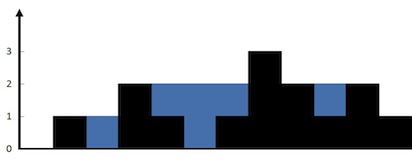已解答
困难
相关标签
相关企业
给定 n 个非负整数表示每个宽度为 1 的柱子的高度图,计算按此排列的柱子,下雨之后能接多少雨水。
示例 1:

输入:height = [0,1,0,2,1,0,1,3,2,1,2,1] 输出:6 解释:上面是由数组 [0,1,0,2,1,0,1,3,2,1,2,1] 表示的高度图,在这种情况下,可以接 6 个单位的雨水(蓝色部分表示雨水)。
示例 2:
输入:height = [4,2,0,3,2,5] 输出:9
提示:
n == height.length1 <= n <= 2 * 1040 <= height[i] <= 105
面试中遇到过这道题?
1/5
是
否
通过次数
1.2M
提交次数
1.9M
通过率
64.8%
相关标签
相关企业
class Solution(object):
def trap(self, height):
"""
:type height: List[int]
:rtype: int
"""
# return 一个雨水的数量
# def check(index,item):
# # 查看左边有没有item+1的元素
# # 查看右边有没有item+1的元素
# flagl = False
# flagr = False
# for i in range(0,index):
# if height[i]>=item+1:
# flagl = True
# for i in range(index,len(height)):
# if height[i]>=item+1:
# flagr = True
# return flagl and flagr
# def get_rain_drop(index,item):
# count=0
# while check(index,item):
# count+=1
# item+=1
# return count
rain_count=0
left_max_height = 0
right_max_height = [0]*len(height)
for i in range(len(height)-2,-1,-1):
right_max_height[i] = max(height[i+1],right_max_height[i+1])
# right_max_height_index = -1
for index,item in enumerate(height):
boundary = min(left_max_height,right_max_height[index])
if boundary>item:
rain_count+=boundary - item
# 更新left , right
# 对于左侧来说只要判断离开的这个item是不是比他高,搞就更新
if item>left_max_height:
left_max_height = item
# 对于右侧来说,要判断刚刚的右侧最高是不是item如果是的话从新找到右侧最高
return rain_count
第一我们要知道如何计算每一个地点的雨水数量
第二计算右侧的最高点需要使用动态规划的算法




















 1878
1878

 被折叠的 条评论
为什么被折叠?
被折叠的 条评论
为什么被折叠?








